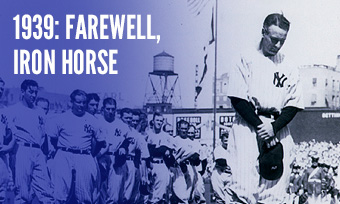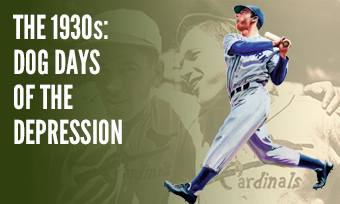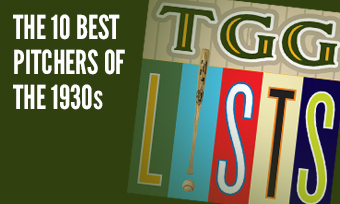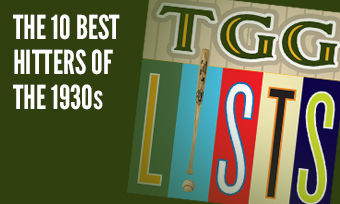The Yearly Reader
Leaders and Honors, 1939
Our list of baseball’s top 10 hitters and pitchers in both the American League and National League for the 1939 baseball season, as well as the awards and honors given to the game’s top achievers of the year.
The National League’s Top 10 Hitters, 1939
Bold type in brick red indicates league leader.
1. Johnny Mize, St. Louis
Key Numbers: .349 average, 104 runs, 197 hits, 44 doubles, 14 triples, 28 home runs, 108 RBIs, 92 walks, 18 intentional walks, .626 slugging percentage.
Mize won his first and only batting title while raising his four-year career average to .346.
2. Joe Medwick, St. Louis
Key Numbers: .332 average, 98 runs, 201 hits, 48 doubles, 8 triples, 14 home runs, 117 RBIs.
Medwick finished off a five-year stretch in which he averaged 52 doubles per season.
3. Dolph Camilli, Brooklyn
Key Numbers: 157 games, .290 average, 105 runs, 30 doubles, 12 triples, 26 home runs, 104 RBIs, 110 walks, 107 strikeouts.
For the second straight year, Camilli topped the century mark in four categories: runs, RBIs, walks, and strikeouts.
4. Frank McCormick, Cincinnati
Key Numbers: .332 average, 99 runs, 209 hits, 41 doubles, 18 home runs, 128 RBIs.
McCormick was clearly the unheralded hero of the Reds, playing stellar first base, notching 200 hits for the second straight year and racking up more homers (18) than strikeouts (16).
5. Mel Ott, New York
Key Numbers: 125 games, .308 average, 85 runs, 27 home runs, 80 RBIs, 100 walks, .449 on-base percentage.
The Giants’ slugger likely would have won his fourth straight NL home run crown had it not been for an injury that virtually sidelined him for the entire month of September; as it was, he finished one behind Johnny Mize.
6. Ival Goodman, Cincinnati
Key Numbers: 124 games, .323 average, 85 runs, 37 doubles, 16 triples, 7 home runs, 84 RBIs, 7 hit-by-pitches, 22 sacrifice hits.
Goodman’s home run output all but vanished, from 30 to seven—but he also produced a career-high batting average and grabbed a whole lot of other extra-base hits.
7. Enos Slaughter, St. Louis
Key Numbers: .320 average, 95 runs, 193 hits, 52 doubles, 5 triples, 12 home runs, 86 RBIs.
In his second year with the Cardinals, Slaughter developed the late groove by hitting .362 over his final 64 games while becoming the first National Leaguer in three years not named Joe Medwick to lead the circuit in doubles.
8. Billy Herman, Chicago
Key Numbers: .307 average, 111 runs, 191 hits, 34 doubles, 18 triples, 7 home runs, 70 RBIs, 66 walks.
Herman survived an early (but brief) benching and put together one of his finest of 15 major league campaigns.
9. Arky Vaughan, Pittsburgh
Key Numbers: .306 average, 94 runs, 182 hits, 30 doubles, 11 triples, 6 home runs, 62 RBIs, 70 walks, 19 sacrifice hits, 12 stolen bases.
The usual excellence for the future Hall-of-Famer both at the plate and at shortstop, along with his second career cycle (on July 19 at New York against the Giants), wasn’t not enough to keep the Pirates from logging their worst record in 22 years.
10. Hank Leiber, Chicago
Key Numbers: 112 games, .310 average, 24 home runs, 88 RBIs.
The former Giant was, along with the Red Sox’ Jim Tabor, the first pair of major leaguers to each hit three home runs on the same day, the Fourth of July.
The American League’s Top 10 Hitters, 1939
1. Ted Williams, Boston
Key Numbers: .327 average, 131 runs, 185 hits, 44 doubles, 11 triples, 31 home runs, 145 RBIs, 107 walks, 12 intentional walks.
Enter the Splendid Splinter: Williams made it loud and clear that he’d be no rookie any pitcher could solve the second time around.
2. Jimmie Foxx, Boston
Key Numbers: 124 games, .360 average, 130 runs, 31 doubles, 10 triples, 35 home runs, 105 RBIs, 89 walks, .464 on-base percentage, .694 slugging percentage.
In a year where durability took a break as Lou Gehrig stepped down and only seven American Leaguers played 150 or more games, Foxx was one of many on this list robbed of everyday play as he missed most of September—in his case, because of appendicitis. Still, Foxx finished an incredible decade in which he hit .336 and averaged 42 homers and 140 RBIs per year.
3. Joe DiMaggio, New York
Key Numbers: 120 games, .381 average, 108 runs, 176 hits, 32 doubles, 6 triples, 30 home runs, 126 RBIs.
Two years before Williams got past .400, DiMaggio nearly did it himself—but his average dropped 20 points over the final three weeks while suffering from a sinus infection. His 53 RBIs in August are the most ever by an American Leaguer in one month.
4. Hank Greenberg, Detroit
Key Numbers: 138 games, .312 average, 112 runs, 32 doubles, 7 triples, 33 home runs, 112 RBIs, 91 walks, 95 strikeouts.
After belting a Herculean 58 homers the year before, Greenberg experienced far more muted (but still excellent) numbers as protection in the lineup became more vulnerable.
5. Bob Johnson, Philadelphia
Key Numbers: .338 average, 115 runs, 184 hits, 30 doubles, 9 triples, 23 home runs, 114 RBIs, 99 walks, 15 stolen bases.
The 1930s closed with Johnson once more proving his value as one of the decade’s most undervalued stars.
6. George Selkirk, New York
Key Numbers: 128 games, .306 average, 103 runs, 21 home runs, 101 RBIs, 103 walks, 12 stolen bases.
Selkirk came as close to successfully emulating Babe Ruth—the man he replaced in the Yankee outfield four years earlier—as he ever would.
7. Red Rolfe, New York
Key Numbers: .329 average, 139 runs, 213 hits, 46 doubles, 10 triples, 14 home runs, 80 RBIs, 81 walks.
The latter-day, leadoff reincarnation of Earle Combs put together his most potent season, setting career highs in nearly all of the above categories.
8. Hal Trosky, Cleveland
Key Numbers: 122 games, .335 average, 89 runs, 31 doubles, 25 home runs, 104 RBIs.
At the age of 26, Trosky was named captain of the Indians and became the team’s primary threat with 1930s star Earl Averill dealt to Detroit in an early-season trade.
9. George McQuinn, St. Louis
Key Numbers: 154 games, .316 average, 101 runs, 195 hits, 37 doubles, 13 triples, 20 home runs, 94 RBIs.
In his second full, very productive year—and on the heels of a first in which he fashioned together a 34-game hit streak—McQuinn proved so convincingly good that the Yankees tried (and failed) to land him in the following offseason. Such a shame for McQuinn, who labored through every game of the Browns’ 43-111 misery of 1939.
10. Charlie Gehringer, Detroit
Key Numbers: 118 games, .325 average, 86 runs, 29 doubles, 6 triples, 16 home runs, 86 RBIs, 68 walks.
At age 36, Gehringer hit for the lone cycle of his career on May 27 at St. Louis against the Browns, jumping his average over the .300 mark after a slow start; he’d never go below the figure again the rest of the year.
The National League’s Top 10 Pitchers, 1939
1. Bucky Walters, Cincinnati
Key Numbers: 2.29 ERA, 27 wins, 11 losses, .711 win percentage, 39 appearances, 36 starts, 31 complete games, 319 innings, 137 strikeouts.
A sloppy third baseman over his first five years in the bigs, Walters reveled with a second calling on the mound—and proved he could still hit by batting .325.
2. Paul Derringer, Cincinnati
Key Numbers: 2.93 ERA, 25 wins, 7 losses, .781 win percentage, 38 appearances, 35 starts, 28 complete games, 5 shutouts, 301 innings, 35 walks.
The veteran Reds ace was just steps behind Walters in most category, despite career bests in wins, ERA and complete games.
3. Bob Bowman, St. Louis
Key Numbers: 2.60 ERA, 13 wins, 5 losses, .722 win percentage, 8 saves, 51 appearances, 15 starts, 169.1 innings.
The one-year wonder was at his best when he relieved, scoring a 6-0 record and 1.78 ERA.
4. Junior Thompson, Cincinnati
Key Numbers: 2.54 ERA, 13 wins, 5 losses, .722 win percentage, 42 appearances, 11 starts.
Lost amid the cries of “wow” for Walters and Derringer was the 22-year-old rookie reliever who, like Bowman above, would also not last terribly long in the majors—thanks in part to his absence during World War II.
5. Claude Passeau, Philadelphia-Chicago
Key Numbers: 3.28 ERA, 15 wins, 13 losses, 42 appearances, 35 starts, 274.1 innings, 137 strikeouts.
Rescued from the Phillies—a familiar story for the time—Passeau was unsurprisingly at his best following an early-season trade to the Cubs.
6. Curt Davis, St. Louis
Key Numbers: 3.63 ERA, 22 wins, 16 losses, 7 saves, 49 appearances, 31 starts, 248 innings, 48 walks, 14 intentional walks.
Obtained in the deal that sent Dizzy Dean to the Cubs, Davis made the $185,000 the Cardinals also received seem like highway robbery.
7. Luke Hamlin, Brooklyn
Key Numbers: 3.64 ERA, 20 wins, 13 losses, 40 appearances, 36 starts, 269.2 innings, 54 walks.
The Dodgers’ workhorse for the moment (before Whit Wyatt and Kirby Higbe arrived on the scene), Hamlin was just as effective as his previous two campaigns but, thanks to belated support, finally reached the promised land of 20 victories.
8. Carl Hubbell, New York
Key Numbers: 2.75 ERA, 11 wins, 9 losses, 29 appearances, 18 starts, 154 innings, 24 walks.
Settled into his post-ace era after elbow injuries neutered his workhorse ethic, Hubbell enjoyed a worthy campaign at age 36.
9. Bill Lee, Chicago
Key Numbers: 3.44 ERA, 19 wins, 15 losses, 37 appearances, 36 starts, 282.1 innings.
A year after his star turn, Lee remained effective but began to feel the effects of leading the NL in games started for three straight years; it would get wobbly for him from here.
10. Cliff Melton, New York
Key Numbers: 3.56 ERA, 12 wins, 15 losses, 41 appearances, 23 starts, 5 saves, 207.1 innings, 6 pickoffs.
Struggling to rekindle the rookie magic of his 1937 season, Melton was given more bullpen activity, where he actually performed better (2.76 ERA vs. 3.84 as a starter).
The American League’s Top 10 Pitchers, 1939
1. Bob Feller, Cleveland
Key Numbers: 2.85 ERA, 24 wins, 9 losses, .727 win percentage, 39 appearances, 35 starts, 24 complete games, 296.2 innings, 142 walks, 246 strikeouts, 14 wild pitches.
Feller became the majors’ youngest 20-game winner until Dwight Gooden.
2. Ted Lyons, Chicago
Key Numbers: 2.76 ERA, 14 wins, 6 losses, .700 win percentage, 21 starts, 16 complete games, 172.2 innings, 26 walks.
If it’s Sunday, it must be Lyons—who was given the ball roughly every seven days, usually at the end of the weekend, and continued to deliver sharp results at age 38. The routine would largely continue well into the 1940s.
3. Lefty Grove, Boston
Key Numbers: 2.54 ERA, 15 wins, 4 losses, .789 win percentage, 23 starts, 191 innings.
Grove ended the 1930s just a win shy of 200 for the decade, and tallied his ninth and last career ERA title at age 39.
4. Red Ruffing, New York
Key Numbers: 2.93 ERA, 21 wins, 7 losses, .750 win percentage, 28 starts, 22 complete games, 5 shutouts, 228.1 innings.
Ruffing continued to be as automatic as the Yankees, finishing the decade with records of 20-12, 20-7, 21-7 and 21-7 for the four-time champs; he also pulled off the rare feat of going the whole season without a no-decision.
5. Dutch Leonard, Washington
Key Numbers: 3.54 ERA, 20 wins, 8 losses, .714 win percentage, 34 starts, 269.1 innings.
Leonard set the mark for wins by anyone named Dutch Leonard—though his unrelated namesake still had him one up on ERA with an all-time low 0.96 mark in 1914.
6. Bobo Newsom, St. Louis-Detroit
Key Numbers: 3.58 ERA, 20 wins, 11 losses, 41 appearances, 37 starts, 24 complete games, 291.2 innings, 126 walks, 192 strikeouts.
Shipped at midseason from St. Louis to Detroit—he was used to it, as it was the third of his eight career mid-season trades—Newsom won 20 games for the second straight year, this time with a far more respectable ERA.
7. Lefty Gomez, New York
Key Numbers: 3.41 ERA, 12 wins, 8 losses, 26 starts, 198 innings.
An arm injury a month into the season quelled Gomez’s campaign and hastened his twilight at the age of just 30, but he remained mostly sharp throughout it all.
8. Bump Hadley, New York
Key Numbers: 2.98 ERA, 12 wins, 6 losses.
The veteran hurler and past two-time 20-game loser for the downtrodden Browns enjoyed his best of six late-career campaigns with the far more successful Yankees.
9. Tommy Bridges, Detroit
Key Numbers: 3.50 ERA, 17 wins, 7 losses, .708 win percentage.
A return to fine form, if while working fewer innings than his mid-1930s peak.
10. Johnny Rigney, Chicago
Key Numbers: 3.70 ERA, 15 wins, 8 losses, 218.2 innings.
The 24-year-old right-hander certainly enjoyed pitching at Comiskey Park (11-1 record, 2.66 ERA) and during July/August (9-0, 2.09 ERA).









